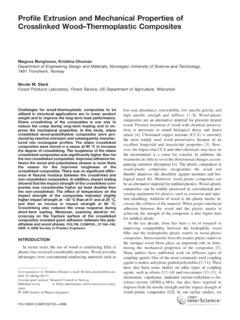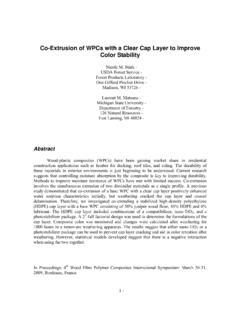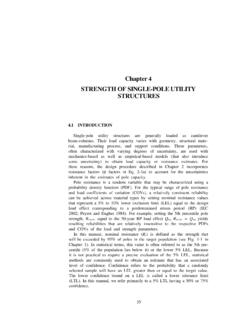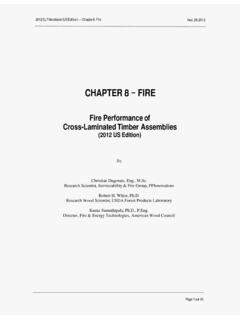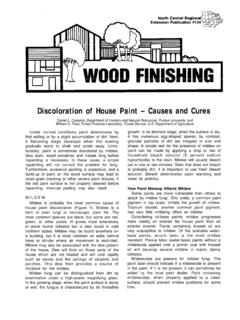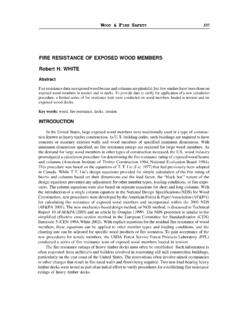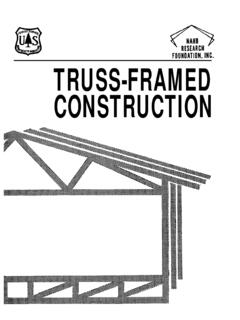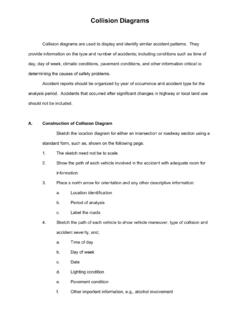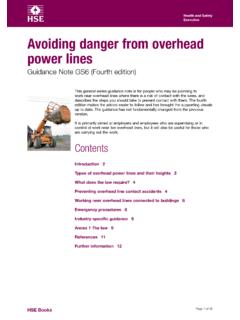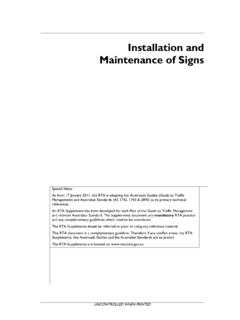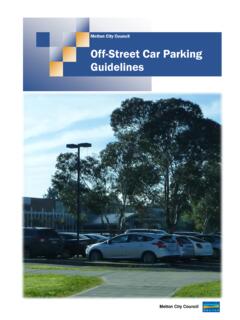Transcription of TYPES OF TIMBER BRIDGES - Forest Products Laboratory
1 TYPES OF TIMBER BRIDGES INTRODUCTION TIMBER BRIDGES are seen today in many TYPES and configurations. Some of these BRIDGES evolved from designs developed many years ago, while others have developed as a result of modem technological advances in TIMBER design and fabrication. Regardless of the specific configuration, all TIMBER BRIDGES consist of two basic components, the superstructure and the substructure (Figure 2-1). The superstructure is the framework of the bridge span and includes the deck, floor system, main supporting mem bers, railings, and other incidental components. The five basic TYPES are the beam, deck (slab), truss, arch, and suspension superstructures. The substructure is the portion of the bridge that transmits loads from the superstructure to the supporting rock or soil.
2 TIMBER substructures include abutments and bents. Abutments support the two bridge ends, while bents provide intermediate support for multiple-span crossings. Figure Basic components of a TIMBER bridge. This chapter provides an introduction to the many TYPES of TIMBER BRIDGES currently used in the United States. Superstructures are discussed first, followed by decks and substructures. Although decks are technically part of the superstructure, they are addressed separately because of their varied application on many superstructure TYPES . 2-1 BEAM SUPERSTRUCTURES Longitudinal beam superstructures are the simplest and most common TIMBER bridge type (in bridge design, the longitudinal direction is meas ured in the direction of the traffic flow).
3 Longitudinal beam superstruc tures consist of a deck system supported by a series of TIMBER beams between two or more supports. Bridge beams are constructed from logs, sawn lumber, glued-laminated TIMBER , or laminated veneer lumber (LVL). Individual beams may be termed stringers or girders, depending on the relative size of the member. Girders are larger than stingers; however, there is no clear-cut definition for either. For clarity, the word beam is used here to collectively define all longitudinal beam elements, including stringers and girders. LOG BEAMS The simplest type of TIMBER bridge is the log beam or native TIMBER bridge. It is constructed by placing round logs alternately tip to butt and binding them together with steel cables.
4 A transverse (perpendicular to traffic flow) distributor log or needlebeam is normally attached to the bridge underside at centerspan to aid in load distribution. The deck for log beam BRIDGES is formed by spiking sawn lumber planks across the log tops (Figure 2-2), or by placing soil and rocks on the logs (Figure 2-3). Figure beam bridge with a transverse plank deck. 2-2 SAWN LUMBER BEAMS Figure Log beam bridge with a gravel deck. The two large brow logs along each side serve to delineate the roadway and function as a type of railing. The span of log beam BRIDGES is limited by the available species and the diameter and length of trees.
5 Clear spans of 20 to 60 feet are most com mon; however, spans approaching 100 feet have been built that support off-highway trucks weighing in excess of 100 tons. Log BRIDGES are generally not treated with preservatives and are primarily used as temporary structures. Service life typically ranges from 10 to 20 years, depending on log species and local conditions of use. Although log beam BRIDGES may appear to be rather crude, they have proven to be very func tional. Hundreds of these BRIDGES are currently in use in the United States and Canada, primarily on logging and other low-volume roads. The basic concept has been adapted into many configurations, some of which are quite sophisticated.
6 Sawn lumber beam BRIDGES are constructed of closely spaced lumber beams that are commonly 4 to 8 inches wide and 12 to 18 inches deep (Figure 2-4). Solid TIMBER blocking or lumber bridging is placed between beams for alignment and lateral beam support. Sawn lumber beam BRIDGES are limited in span by the availability of lumber beams in the required sizes. They are most commonly used for clear spans of 15 to 25 feet with a practical maximum for highway loads of approximately 30 feet (Figure 2-5). Longer crossings are achieved by using a series of simple spans with intermediate supports. 2-3 Figure Underside of a sawn lumber beam bridge showing the characteristic close beam spacing.
7 This photo is of the center bent of a two-span crossing, where beams from the two spans overlap at the support. Figure Typical sawn lumber beam bridge. Most lumber beam BRIDGES of this type span 25 feet or less, but longer spans have been built where large beams are available. 2-4 GLUED-LAMINATED TIMBER BEAMS Sawn lumber beam BRIDGES have been built in the United States for gen erations. They are economical, easy to construct, and well suited to secon dary and local roads where long clear spans are not required. The service life of lumber BRIDGES treated with preservatives averages about 40 years. Although their use has declined significantly since the introduction of glulam, many of the sawn lumber beam BRIDGES built in the 1930 s and 1940 s are still in service.
8 Glulam BRIDGES are constructed of glulam beams manufactured from 1-1/2- or 1-3/8-inch-thick lumber laminations that are bonded together on their wide faces with waterproof structural adhesive. The beams are available in standard widths ranging from 3 inches to 14-1/4 inches, with beam depth limited only by transportation and pressure-treating size considerations. Because of the large size of glulam beams, glulam beam BRIDGES require fewer beams and are capable of much longer clear spans than conventional sawn lumber beam BRIDGES (Figure 2-6). They are most commonly used for spans of 20 to 80 feet, but have been used for clear spans over 140 feet (Figure 2-7). The length of the beams, and thus the bridge, is normally limited only by transportation restrictions for moving the beams to the construction site.
9 Figure Underside of a glulam beam bridge. Because glulam beams are manufactured in a wide range of sizes, glulam BRIDGES typically have larger beams and a greater beam spacing compared to conventional sawn lumber beam BRIDGES (photo courtesy of Weyerhaeuser Co.). 2-5 LAMINATED VENEER LUMBER BEAMS Figure Glulam beam bridge over Dangerous River, near Yukatat, Alaska. This bridge consists of three 143-foot spans, each of which is supported by four glulam beams that are 91-1/2 inches deep (photo courtesy of the Alaska Department of Transportation and Public Facilities). The first glulam beam BRIDGES were built in the mid-1940 s.
10 Since that time, they have become the most common type of TIMBER bridge in both single- and multiple-span configurations. Glulam beam BRIDGES are com pletely prefabricated in modular components and are treated with pre servatives after fabrication. When properly designed and fabricated, no field cutting or boring is required, resulting in a service life of 50 years or more. Laminated veneer lumber, a subcategory of new wood Products called structural composite lumber, is a relatively new material for use in bridge construction. It is made from sheets of thin veneer that are glued together to form structural members. The veneer laminations are approximately 1/10 inch to 1/2 inch thick and are oriented vertically, instead of horizon tally, as in glulam beams (Figure 2-8).
